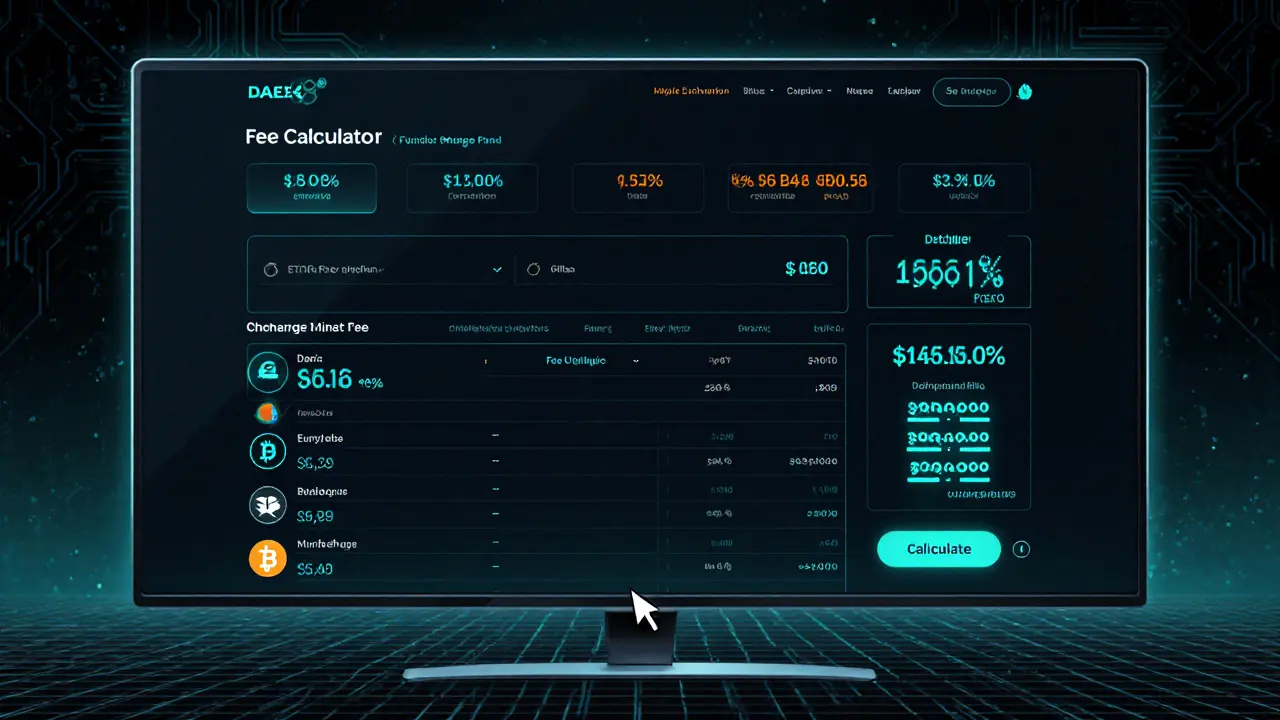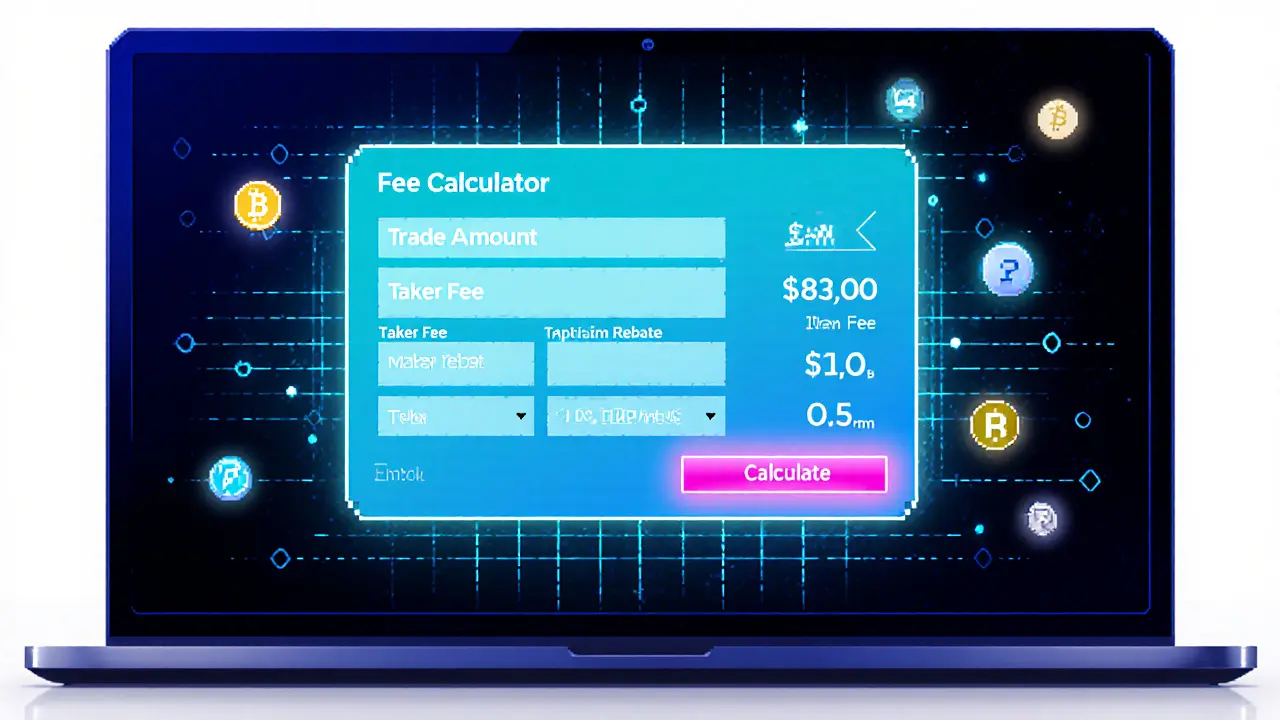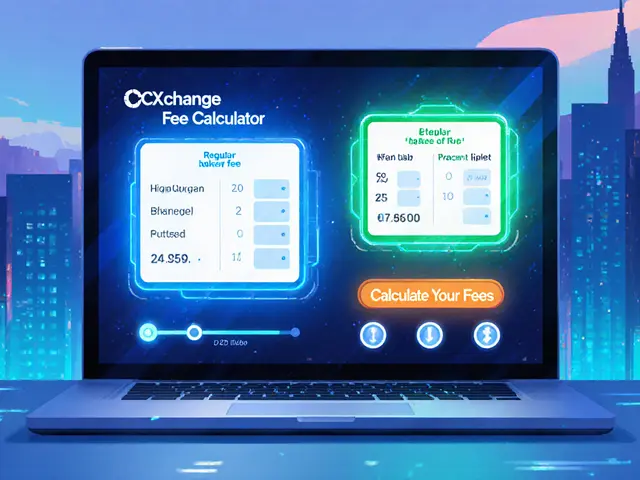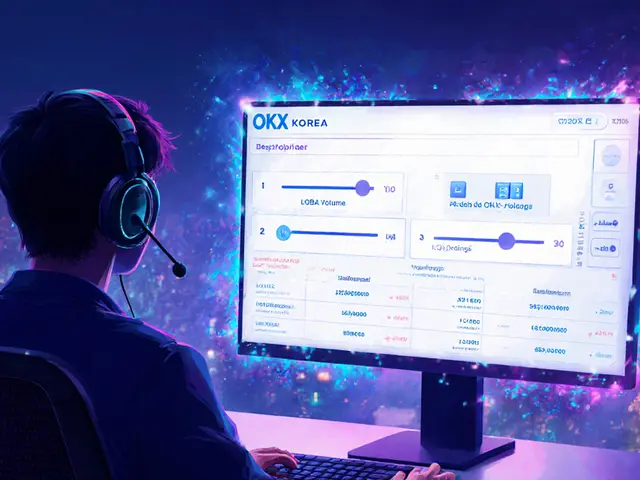Daexs Exchange Fee Calculator
Maker Fee
0.08%
Earned by providing liquidity
Taker Fee
0.12%
Paid when trading
Fee Breakdown
Estimated fees based on your trade volume:
- $10,000 trade volume
- Maker fee: $8 (0.08%)
- Taker fee: $12 (0.12%)
- Volume discount applies for >$100k monthly volume
How Daexs Fees Compare
Daexs offers competitive fees compared to other DEXs:
- Uniswap: 0.30% (0.05% on stable pools)
- PancakeSwap: 0.25% flat
- Daexs: 0.08% maker / 0.12% taker
When you hear the name Daexs Exchange is a newly launched decentralized crypto exchange that promises fast swaps, low fees, and non‑custodial trading, the first question is: does it live up to the hype?
Key Takeaways
- Daexs is a permission‑less DEX focused on Ethereum and BNB Chain assets.
- Trading fees start at 0.08% for makers and 0.12% for takers, with discounts for high‑volume users.
- Security hinges on audited smart contracts and a built‑in liquidity‑insurance pool.
- Its UI mirrors centralized exchanges, making it beginner‑friendly.
- Compared to Uniswap, PancakeSwap, and IDEX, Daexs offers slightly lower fees but less liquidity overall.
What Is Daexs Exchange?
Daexs positions itself as a hybrid DEX: the front‑end feels like a traditional exchange, yet all assets stay in the user’s wallet. The platform launched in early 2025 and currently supports ERC‑20 and BEP‑20 tokens. It runs on an automated market maker (AMM) model similar to Uniswap, but adds order‑book‑style limit orders through a proprietary “Dual‑Pool” system.
Getting Started: Step‑by‑Step
- Connect a Web3 wallet (MetaMask, Trust Wallet, or Binance Chain Wallet).
- Deposit the tokens you want to trade - Daexs does not hold your funds.
- Choose between a market swap or a limit order. The limit order panel shows real‑time depth from the Dual‑Pool.
- Confirm the transaction and sign the wallet prompt. The trade settles instantly on‑chain.
- Optional: Join the liquidity pool to earn a share of the 0.08% maker fee.
Fees & Trading Costs
Daexs follows a tiered fee schedule:
- Maker fee: 0.08% (reduced to 0.04% after $100k 30‑day volume).
- Taker fee: 0.12% (drops to 0.06% for the same volume threshold).
- Liquidity providers earn the maker portion, effectively subsidizing the taker cost.
- No hidden gas‑metering fees - you only pay the network gas for the swap.
For comparison, Uniswap’s standard fee is 0.30% (or 0.05% on its v3 stable‑coin pools), while PancakeSwap charges a flat 0.25%.

Security & Custody
Daexs advertises a “no‑custody” model: private keys never leave your wallet. The platform’s contracts underwent a public audit by CertiK in March 2025, with a focus on re‑entrancy protection and flash‑loan resistance. Additionally, Daexs maintains a liquidity‑insurance fund that reimburses users up to $5million in case of a smart‑contract exploit.
Feature Set Compared to Other DEXs
Below is a quick look at how Daexs stacks up against the big players:
| Feature | Daexs Exchange | Uniswap | PancakeSwap | IDEX |
|---|---|---|---|---|
| Supported chains | Ethereum, BNB Chain | Ethereum, Polygon, Optimism, Arbitrum | BNB Chain, Ethereum (via bridge) | Ethereum, BNB Chain, Polkadot |
| Fee structure | 0.08% maker / 0.12% taker | 0.30% (0.05% on v3 stable pools) | 0.25% flat | 0.10% maker / 0.20% taker |
| Order types | Market, Limit (Dual‑Pool) | Market only (AMM) | Market only | Market, Limit, Stop‑Limit |
| Liquidity depth (USD) | ≈ $120M (as of Sep2025) | $4B+ | $2B+ | $350M |
| Mobile app | iOS & Android (Beta) | No official app | iOS & Android | No mobile app |
Pros & Cons
Pros
- Lower fees than most established AMMs.
- Limit‑order functionality without giving up custody.
- Simple UI that feels like a centralized exchange.
- Liquidity‑insurance fund adds a safety net.
Cons
- Liquidity is modest - large trades may experience slippage.
- Still a newcomer; community and developer support are limited.
- No native fiat on‑ramps; you must bridge from another exchange.
- Mobile app is in beta, with occasional bugs.
Who Should Consider Daexs?
If you’re a trader who wants lower fees than Uniswap but isn’t ready to sacrifice the safety of non‑custodial trading, Daexs is a solid middle ground. It’s especially attractive for:
- DeFi enthusiasts who already use MetaMask and want a hybrid UI.
- Liquidity providers looking for modest returns on the Dual‑Pool.
- Users trading mostly ERC‑20 and BEP‑20 tokens with daily volumes under $500k.
High‑frequency or massive‑volume traders may still prefer the deep liquidity of Uniswap or the specialized tools of dYdX.
Final Verdict
Daexs Exchange fills a niche that’s been missing: a user‑friendly interface combined with true decentralization and limit orders. While it can’t rival the TVL of Uniswap or PancakeSwap, its fee structure and insurance fund make it a compelling option for everyday traders who value control over their keys.

Frequently Asked Questions
Is Daexs a centralized exchange?
No. Daexs is a decentralized exchange. All trades are executed on‑chain and you keep custody of your private keys.
Can I trade Bitcoin on Daexs?
At the moment Daexs only supports tokens on Ethereum and BNB Chain, so native BTC isn’t available. You can trade wrapped Bitcoin (WBTC) if you have it on the supported networks.
How does Daexs protect against front‑running?
The Dual‑Pool architecture batches limit orders and executes them at the next block, reducing the window for front‑running bots. Additionally, the platform uses Solidity’s built‑in checks to prevent re‑entrancy attacks.
What are the gas costs when using Daexs?
Gas fees are network‑dependent. On Ethereum Mainnet, a typical swap costs around $12‑$15 (as of Sep2025). On BNB Chain, the same transaction is usually under $0.10.
Is there a mobile app for Daexs?
A beta version of the Daexs mobile app is available for iOS and Android. It mirrors the web UI but may have occasional synchronization issues.









Carl Robertson
March 31, 2025 AT 22:51Man, Daexs tries to be the slick new kid on the block, but the hype feels forced. The fee cuts are nice on paper, yet the liquidity depth is a joke compared to Uniswap. If you try to move a decent chunk, expect nasty slippage. The UI might look polished, but that's about it. Overall, it's a flash‑in‑the‑pan attempt to grab market share.
Rajini N
April 11, 2025 AT 08:51If you're looking for a quick walkthrough, start by connecting MetaMask and double‑check the network selection. Daexs uses a Dual‑Pool system, which essentially batches limit orders to reduce front‑running. The fee calculator on the site is accurate; just plug in your volume to see the exact maker/taker rates. Remember that the insurance fund only covers contract exploits, not market losses. This approach makes Daexs fairly user‑friendly for newcomers.
Sidharth Praveen
April 21, 2025 AT 18:51Honestly, the lower fees are a breath of fresh air for small traders. The ability to place limit orders without handing over custody is a real game‑changer. As long as you keep an eye on slippage, Daexs can fit nicely into a diversified DeFi strategy. Give it a spin and see if the UI feels natural to you.
Sophie Sturdevant
May 2, 2025 AT 04:51From a technical standpoint, Daexs implements a hybrid AMM‑order‑book model that leverages Solidity's re‑entrancy guards. The CertiK audit adds a layer of confidence, though no audit can guarantee absolute safety. Liquidity providers earn the maker fee slice, effectively subsidizing taker costs for traders. The insurance pool covering up to $5 million is a solid safety net, but remember it's contingent on the fund's solvency. In short, Daexs brings a respectable blend of security and functionality.
Nathan Blades
May 12, 2025 AT 14:51Wow, that deep dive hits the nail on the head! The philosophical angle of mixing custodial‑free trading with familiar UI is exactly what the market craves. It's like giving us the freedom of DeFi with the comfort of a centralized exchange. Sure, the liquidity isn’t there yet, but the roadmap seems ambitious. If they stick to this vision, Daexs could become a cornerstone of the next-gen DEX ecosystem.
Somesh Nikam
May 23, 2025 AT 00:51Totally agree 😊 The dual‑pool design feels like a bridge between old‑school order books and modern AMMs. For newcomers, the step‑by‑step guide reduces friction, and the community has been pretty helpful in the Discord. Just keep an eye on gas fees during peak times, especially on Ethereum. All in all, Daexs is shaping up to be a solid addition to my toolkit.
Jan B.
June 2, 2025 AT 10:51Daexs fee structure looks clean and the UI is easy to navigate.
MARLIN RIVERA
June 12, 2025 AT 20:51Clean? Please. The so‑called “easy UI” just masks the shallow depth and hidden gas spikes. Anyone who thinks 0.08% maker is a deal ignores the real cost of slippage on a $120 M pool. Don’t be fooled by marketing fluff.
Debby Haime
June 23, 2025 AT 06:51Hold up, the fees are indeed lower than most AMMs, and the insurance fund isn’t just a gimmick. While liquidity isn’t massive yet, it’s growing, and early adopters often enjoy the best rates. Let’s not discount the platform’s potential because of hype cycles.
emmanuel omari
July 3, 2025 AT 16:51From my perspective, Daexs is a prime example of how Western crypto projects neglect the African market’s needs. They ignore local fiat on‑ramps and assume everyone can bridge at will. If they truly wanted global adoption, they’d integrate more region‑specific solutions.
Andy Cox
July 14, 2025 AT 02:51Interesting point, but I think the platform’s focus on Ethereum and BNB Chain reflects where most liquidity currently lives. Adding more fiat gateways could help, yet it’s a massive compliance hurdle.
Courtney Winq-Microblading
July 24, 2025 AT 12:51The philosophical undercurrent here is that technology often outpaces regulatory frameworks, creating a tension between innovation and inclusion. Daexs sits at that crossroads, offering cutting‑edge features while still navigating the global compliance maze. Its future will depend on how adeptly it can balance those forces.
katie littlewood
August 3, 2025 AT 22:51When I first stumbled upon Daexs, I was immediately drawn to its promise of lower fees and a user‑friendly interface, which is a rare combination in the current DEX landscape. The dual‑pool architecture, as described in the whitepaper, attempts to harmonize the speed of an AMM with the precision of limit orders, and that concept alone is worth a deeper look. In practice, I found the onboarding process surprisingly smooth: connecting a wallet, selecting a token pair, and executing a trade took less than two minutes, which is a stark contrast to the often‑clunky experiences on older platforms. The fee calculator embedded on the site is transparent, showing both maker and taker rates clearly, and the tiered discount system for high‑volume traders can meaningfully reduce costs for power users. Moreover, the insurance fund, backed by a $5 million reserve, provides an added layer of confidence that many newer projects simply lack, although it’s important to remember that insurance does not protect against market volatility. Liquidity, while not on par with giants like Uniswap, has been steadily climbing and currently sits around $120 million, which is respectable for a platform launched only a few months ago. The ability to place limit orders without relinquishing custody is a game‑changer for traders who have been wary of centralized order books. Gas fees remain a consideration-Ethereum transactions can still be pricey during peak congestion, but the option to trade on BNB Chain offers a cheaper alternative. Community support is another highlight; the Discord channel is active, and developers often respond to feedback within hours, fostering a sense of collaborative development. On the downside, the mobile app is still in beta, and I’ve encountered occasional sync issues that need to be ironed out before it can be deemed production‑ready. Also, while the platform’s UI feels modern and intuitive, power users accustomed to the depth of traditional order books might miss some advanced features that are still in the roadmap. Security-wise, the CertiK audit adds credibility, yet no audit can fully eliminate the risk of future exploits, so users should remain vigilant. In terms of market positioning, Daexs occupies a niche between full‑service centralized exchanges and purely permissionless AMMs, aiming to attract traders who value both control and convenience. Overall, my experience suggests that Daexs is a solid addition to the decentralized finance ecosystem, especially for those who prioritize lower fees and non‑custodial trading, but it still has room to grow in liquidity depth and mobile stability. I recommend giving it a try, particularly if you’re already active on Ethereum or BNB Chain and are looking for an alternative to the high‑fee environments of other DEXs. Finally, keep an eye on upcoming feature releases, as the team seems committed to iterating quickly based on community input.
Jenae Lawler
August 14, 2025 AT 08:51While the foregoing exposition is thorough, one must temper enthusiasm with a rigorous assessment of systemic risk and market depth constraints. The comparative analysis suggests that Daexs, despite commendable advancements, remains subordinate in total value locked to its incumbents. Accordingly, prudent investors should allocate capital judiciously and monitor liquidity trends before committing significant positions.
Chad Fraser
August 24, 2025 AT 18:51Fair point! But let’s not forget that early adopters often reap the biggest rewards once a platform scales. I’m optimistic that Daexs will close the gap quickly with its community‑driven roadmap.
Jayne McCann
September 4, 2025 AT 04:51Fees are decent but liquidity still lags behind the major DEXs.
Richard Herman
September 14, 2025 AT 14:51True, the cost advantage is clear, yet the limited depth can cause slippage, so it’s best for moderate‑sized trades until the pool expands.